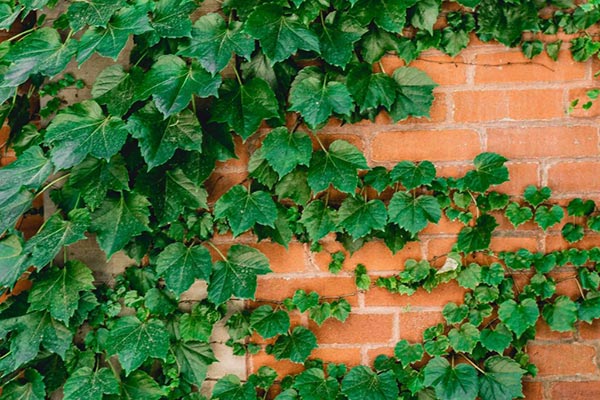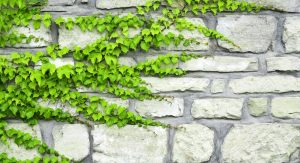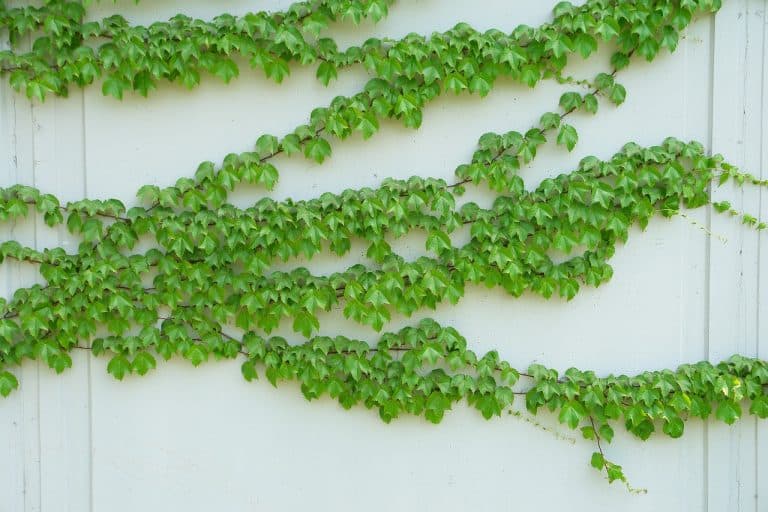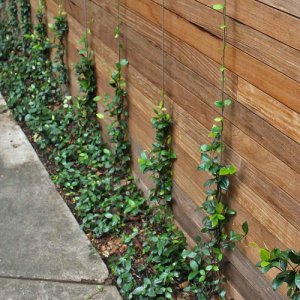What is a climbing plant?
Climbers, or creepers, are plants which naturally grow up vertical structures such as cliffs, walls and trees using twining stems, tendrils, thorns and suckers. Many of these can also grow on a flat surface as a groundcover.
Climbers can be a gorgeous addition to every design and make walls, or any vertical space into a great feature in your garden.

How climber plants are used in a design
Climber plants can be used to hide an ugly wall or fence, soften aspects of your garden, create shade, form a privacy screen, or as groundcover.
Adding a trellis, archway or an arbour can create private spaces or form a focal point in your garden that will soften and complement the natural beauty of your landscape.
Why climbers can cause problems
Some climbers can cause trouble and even damage once they are well-established and form a large, heavy, fast-growing mass.
Once it has spread out and used up all the space you originally allowed, it will begin to encroach on surrounding parts of your garden. Climbers can smother smaller plants and shrubs, even trees, stealing their light, breaking, damaging and eventually killing them.
The sizable weight of a fast-growing climber can cause fences to lean or collapse, and its roots can dig their way into cracks in the mortar in brick or stone walls and damage or break them.
The dense growth can hide rats and wasp nests, prevent light and warmth from entering windows, and shoots can invade gutters and roofs forming fire hazards or blockages.
That’s a lot of doom and gloom, but by being aware of all the potential issues, you can plan ahead in your design and know how to prevent problems by careful planting, selection and maintenance.
Climbing plants to avoid
These are much less common as they well-known to be trouble, and in Perth can cause problems by invading bushland, but can still be hanging around in older gardens unbeknownst to the owner.

- Dolichos Pea
- Cape Ivy
- Climbing Groundsel
- Balloon Vine
- Cats Claw
- Moth Vine
- Morning Glory (blue or pinkish-mauve flowers)
- English Ivy
- Bridal Creeper
- Madeira Vine
These climbers grow rampantly and can quickly overwhelm a garden. The Morning Glory can kill birds with its toxic seeds and the English Ivy has aerial roots that will adhere for years on most surfaces.
Removing Troublesome Climbers
Sometimes climbers become too much and need to go and be replaced by something much more low-maintenance, but this can be a tough ask. You may need to call in a specialist.
In some cases, applying glyphosate will kill the climber, although it may take a few applications to completely eradicate it. Don’t worry about pruning it first as glyphosate works best with plenty of foliage.
Ivy is almost impossible to entirely remove. Glyphosate will brown the foliage but won’t often kill the plant. Cut through the stems at around waist height and the growth above will die and can be pulled down, however, digging out the roots may take years.
Vines with tubers, like Madeira vine and bridal creeper, are practically impossible to remove since the tubers will remain in the soil.
Do NOT dump green waste in bushland as it will invade and destroy the native plants. Either put pruning’s in the green waste bin or on the verge, or take to the dump in a closed trailer so seeds and cuttings can’t fall out and cause problems.
Safer climbing plants to use
Many climbing plants are able to be used for enough coverage without the risk of overwhelming, so choose from the list below or ask either garden centre or nursery staff (or a professional gardener) to recommend the right one for your space.
Here are just a few options – and there are many more!
- Jasmine
- Brazilian Jasmine
- Star Jasmine
- White Potato Creeper
- Snail Creeper
- Rata Vine
- Bleeding Heart Vine
- Purple Coral Pea
Popular Climbers – which require extra care!
You can’t live in Perth long without seeing the popular and lovely Bougainvillea around, but many people choose it for its looks and quickly realise how troublesome it can be.
The strong thorns will latch on to anything possible and help it grow to substantial heights – but they can cause serious damage and be very tricky (and painful) to prune. Use standard forms that can create a nice little tree for easy maintenance, or dwarf cultivars which can be container-grown. Prune mercilessly after flowering and it will bloom twice as well in the next season while also keeping those long canes in check.
This is just one example of a popular climber, and these others can also be used so long as they are located carefully and pruned often. Try not to let your climbers mix with each other as later removal will turn into a nightmare, as well as making pruning more difficult.
Other popular climbers which need careful maintaining are…
- Cape Honeysuckle
- Wisteria
- Pink Trumpet Vine
- Orange Trumpet Creeper
- Chinese Trumpet Vine
- Coral Vine
- Black-Eyed Susan
Climbers are high-maintenance and do come with some potential problems to be aware of. But, they can also add a lot of beauty to your garden and be an excellent addition to any design when planned and maintained correctly.
Make sure to consult an expert to cover your bases and ensure you know the best way to plant and care for your climbing plants. Contact us with any questions you have and we can even assist with the planting and maintenance for total peace of mind!


